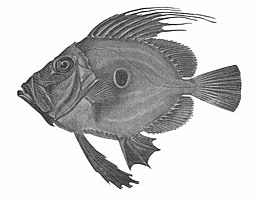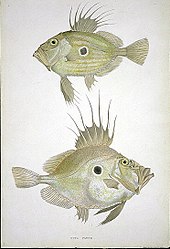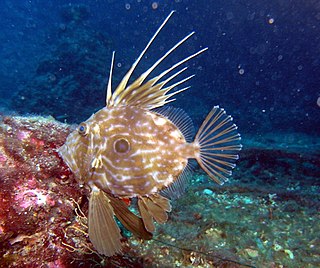
The Zeiformes are a small order of exclusively marine ray-finned fishes most notable for the dories, a group of common food fish. The order consists of about 33 species in six extant families, mostly deep-sea types.
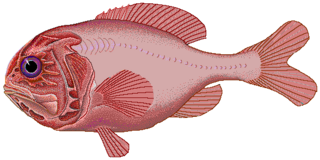
Slimeheads, also known as roughies and redfish, are mostly small, exceptionally long-lived, deep-sea beryciform fish constituting the family Trachichthyidae. Found in temperate to tropical waters of the Atlantic, Indian, and Pacific Oceans, the family comprises about 50 species in eight genera. Slimeheads are named for the network of muciferous canals riddling their heads.

The Zeidae are a family of large, showy, deep-bodied zeiform marine fish—the "true dories". Found in the Atlantic, Indian, and Pacific Oceans, the family contains just six species in two genera. All species are important and highly regarded food fish supporting commercial fisheries, and some—such as the John Dory —are enjoyed in large public aquaria. These fish are caught primarily by deep-sea trawling.

The parore also known as luderick, black bream, black snapper or blackfish is a species of marine ray-finned fish, a sea chub from the family Kyphosidae which is found in the southwestern Pacific Ocean off Australia and New Zealand. Parore or paraore is the common name in New Zealand but in Australia luderick is preferred.

The notchheaded marblefish is a species of marine ray finned fish, one of the marblefishes belonging to the family Aplodactylidae. It is found in the southwestern Pacific Ocean.
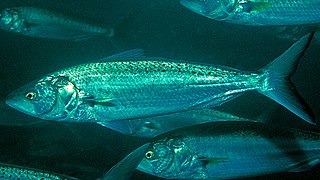
Arripis trutta, known as the Australian salmon in Australia and as kahawai in New Zealand, is a South Pacific marine fish and one of the four extant species within the genus Arripis, native to the cooler waters around the southeastern Australian coasts and the New Zealand coastline. Other common names for this species include Eastern Australian salmon, bay trout, blackback salmon, buck salmon, cocky salmon, colonial salmon, newfish and salmon trout.

The New Zealand turbot, Colistium nudipinnis, is a righteye flounder of the subfamily Rhombosoleinae in the family Pleuronectidae, found around New Zealand in shallow enclosed waters.

The bluefin gurnard or Pacific red gurnard is a species of marine ray-finned fishes belonging to the family Triglidae, the gurnards and sea robins. Its Māori names are kumukumu and pūwahaiau. It is found in the western Indian Ocean and the western Pacific Ocean, being common around Australia and New Zealand at depths down to 200 metres (660 ft). The fish is one of the most important commercial fish species in New Zealand.

Helicolenus percoides, the reef ocean perch, coral cod, coral perch, Jock Stewart, kuriarki, ocean perch, red gurnard perch, red gurnard scorpionfish, red ocean perch, red perch, red rock perch, scarpee or sea perch, is a species of marine ray-finned fish belonging to the subfamily Sebastinae, part of the family Scorpaenidae. It is found in the southwestern Pacific Ocean.

The sargassum fish, anglerfish, or frog fish is a species of marine ray-finned fish belonging to the family Antennariidae, the frogfishes, the only species in the genus Histrio. It lives among Sargassum seaweed which floats in subtropical oceans. The scientific name comes from the Latin histrio meaning a stage player or actor and refers to the fish's feeding behaviour.
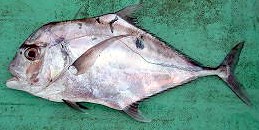
The African pompano, also known as the pennant-fish or threadfin trevally, is a widely distributed species of tropical marine fish in the jack family, Carangidae. The species is found in tropical waters worldwide, with adults often inhabiting coastlines, while juveniles are usually pelagic, floating with ocean currents. The adult African pompano is similar in appearance to the other members of the genus Alectis, with the concave shape of the head near the eyes; the clearest distinguishing feature. The juveniles are similar to other members of Alectis, having long, filamentous dorsal and anal fin tips which are thought to discourage predators. The species lives in depths less than 100 m, consuming a range of crustaceans and small fishes. The species is of minor economic importance, often taken amongst other tropical midwater fishes by hook and line, while juveniles are occasionally caught in beach seines. African pompano are also highly rated game fish, often considered one of the strongest of the jacks in larger sizes.

Mullus barbatus is a species of goatfish found in the Mediterranean Sea, Sea of Marmara, the Black Sea and the eastern North Atlantic Ocean, where its range extends from Scandinavia to Senegal. They are fished, mostly by trawling, with the flesh being well regarded. The International Union for Conservation of Nature has assessed their conservation status as being of "least concern".

The African threadfish, also known as the Alexandria pompano, is a species of large marine fish in the jack family, Carangidae. The species is distributed along the coast of tropical Africa in the eastern Atlantic Ocean, extending to the Mediterranean Sea. Adults live predominantly in waters shallower than 70 m deep, often forming small schools. The African threadfish is similar in appearance to the closely related and co-occurring African pompano, with the species' most definitive feature its slightly concave head profile. Like other members of the genus Alectis, the juveniles of the species have long trailing dorsal and anal fins. The African threadfish is of minor commercial importance, and is also considered to be a game fish.
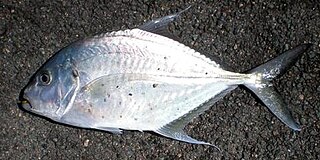
The longnose trevally, also known as the tea-leaf trevally, club-nosed trevally, grunting trevally or dusky trevally, is a species of inshore marine fish in the jack family, Carangidae. The species is distributed throughout the tropical and subtropical waters of the Indian and west Pacific Oceans from South Africa to New Zealand and Japan, inhabiting coastal waters, especially reefs, to a depth of 90 m. The longnose trevally is distinguished from similar species by a combination of a scaleless breast and the number of gill rakers and fin rays. It is a moderately large fish, growing to a maximum known length of 72 cm and 4.35 kg. The longnose trevally is a predatory fish, consuming small fish, crustaceans and molluscs. The species is of minor commercial importance throughout its range, and is considered to be a good table fish.

The blacktip trevally, also known as the blacktip kingfish or yellowtail kingfish, is a species of large marine fish classified in the jack family Carangidae. The blacktip trevally is distributed throughout the tropical to subtropical Indian and West Pacific Oceans, ranging from South Africa in the west to Fiji, Japan and northern Australia in the east. It inhabits coastal waters throughout its range, preferring moderately deep clear waters over rocky and coral reefs. The blacktip trevally is easily distinguished by its yellow fins and a dark upper caudal fin lobe which gives the species its common name, as well as a host of other anatomical features. The species is known to reach a maximum size of 1 m. It is a benthopelagic predator, commonly forming small shoals where it takes a variety of fishes, cephalopods and crustaceans as prey. Little is known of reproduction in the species, and spawning is assumed to take place in more tropical regions of its range, with juveniles known to inhabit bays and large estuaries. Blacktip trevally are often caught using hook and line and various nets in commercial fisheries although don't make up a large part of the market. They are also popular with anglers due to their fighting ability and decent table qualities.

Coastal fish, also called inshore fish or neritic fish, inhabit the sea between the shoreline and the edge of the continental shelf. Since the continental shelf is usually less than 200 metres (660 ft) deep, it follows that pelagic coastal fish are generally epipelagic fish, inhabiting the sunlit epipelagic zone. Coastal fish can be contrasted with oceanic fish or offshore fish, which inhabit the deep seas beyond the continental shelves.

Modern Cookery for Private Families is an English cookery book by Eliza Acton. It was first published by Longmans in 1845, and was a best-seller, running through 13 editions by 1853, though its sales were later overtaken by Mrs Beeton. On the strength of the book, Delia Smith called Acton "the best writer of recipes in the English language", while Elizabeth David wondered why "this peerless writer" had been eclipsed by such inferior and inexperienced imitators.

Platycephalus caeruleopunctatus, the bluespotted flathead, drift flathead, Eastern blue-spot flathead, longnose flathead, red flathead, red spotted flathead, sand flathead or yank, is a species of predatory ray-finned fish belonging to the family Platycephalidae, the flatheads. Bluespotted flathead are a marine species and are predominantly found in offshore waters and coastal bays on the east coast of Australia where they are almost exclusively found on marine sand.
Zaniolepis frenata, also known as the shortspine combfish, is a species of ray-finned fish belonging to the family Zaniolepididae.The species occurs in the eastern Pacific Ocean.

Arripis truttacea, the Western Australian salmon, is a species of marine ray-finned fish within the genus Arripis, the only genus within the family Arripidae. It is endemic to the seas off southern Australia.

